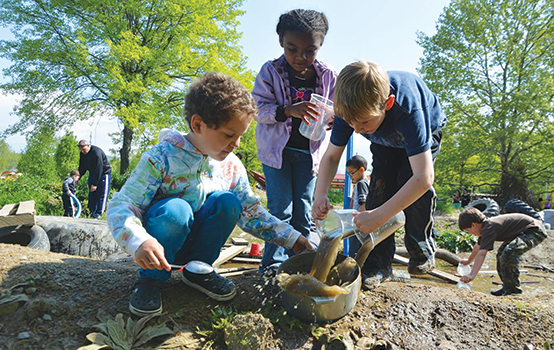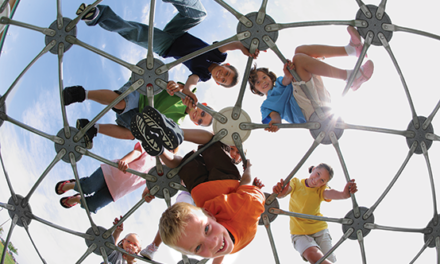
Transforming recess requires changing the playing fields and schoolyards where recess has traditionally taken place.
Gone are the days when kids walked to school, played in creeks, and spent endless hours unsupervised outdoors in all seasons and weather. Recess at school was a time to relax from the focus of the classroom, stretch your legs, hang with friends, test your strength, engage in organized games, or spend time creating imaginative worlds of your own creation. As kids, many of us thought this was the most important part of the day — the time when we were free to be ourselves. It was the time when kid culture was at the forefront of our day, where our ideas ruled, and kids determined the dynamics of each moment. Do you remember those periods of long recess times from your childhood? And what about your out-of-school play time — were you a free-range kid? Did you have opportunities to explore, create, and discover on your own or with friends without the direction of adults? What about children today?
Many adults have fond memories of free, unstructured play during our childhood days. In our hearts, we understand the importance of recess and play time for all ages in our schools. But we also understand the current climate of academic testing, standards, school ratings, funding restrictions, and so on. Couple the push to excel and leave no children behind with the fear of injury, accidents, and lawsuits on playgrounds, and it’s no wonder there’s been a shift in playtime during the school day. School districts across the country have been slowly limiting recess and children’s free time at schools with many schools taking the drastic step of eliminating recess altogether. Well-intentioned school boards and administrators desperate for more academic time to help children learn and grow have weighed options and made difficult choices, with some districts opting to cut recess and break time in favor of more “serious” class time endeavors. This philosophy appears to hold that more time working and less time playing will make smarter students. Teachers and schools that have taken this to the extreme even withhold recess from students as a form of punishment.
Transforming recess
As a natural playground and schoolyard designer, I’ve been working with schools across the U.S. and around the world that are not only keeping recess as a vital part of their students’ days but extending and enhancing recess by adding materials to the outside space to inspire children’s self-directed play. These new play patterns boost creativity, problem-solving skills, mental focus, and collaborative social play.
“Play is our brain’s favorite way of learning.” — Diane Ackerman, author
These schools are part of a new movement to bring play back into the lives of children of all ages. They’ve discovered that limiting children’s access to free play and recess actually has a detrimental effect on children’s attention spans, academic abilities, and enthusiasm for school in general. Pushing more academics and limiting free time and play exhausts children and teachers alike and can lead to many schools experiencing more challenging behavior issues in classrooms and more stress on teachers, students, and families.
American schools are looking internationally for models of rich play incorporated into the daily lives of children. Finland, for example, which is highly lauded for its performance on international tests, also boasts the longest recess of any country in the world (the average Finnish student has 75 minutes a day of recess and teachers give the kids a 15-minute break after every lesson). According to TVNZ, after Swanson Primary School in Auckland, New Zealand, did away with rules on the playground for a university research study, the results went so well that the school opted to make the changes permanent. The school saw a drop in bullying, serious injuries, and vandalism while concentration levels in class increased (TVNZ, 2014). School districts across England are adding “play pods” to recess — storage units filled with loose play materials with which children can create their own play opportunities and change their own environment, experiences that fixed playground equipment and blacktop cannot provide. So-called forest schools in Scandinavian countries have opened their schools to the outdoors, creating outside classrooms, serving meals outside, and offering extended free play time with loose parts in a natural setting. Schools in Scotland, inspired by these models, have developed guidelines on how staff and administrators can support free play and recess in woodland and natural areas on school grounds. With so many examples of schools like these transforming the idea of play, outside time, and recess with great success, why aren’t we following these movements? Actually, we are.
The key is not just bringing back recess but transforming recess by making it more stimulating, more open-ended, and more kid-directed and by offering choices that go beyond fixed equipment and paved blacktop and instead creating spaces for connecting with nature, building and construction, invention and making, and interacting with animals, the seasons, rain and water systems, and sustainable energy.
I work with schools all over the country (and world) that are transforming how they support recess, free play, and outside time — by transforming their outdoor spaces to match. I work with schools to re-envision their school grounds as places of beauty, play, and discovery, with the outdoors becoming an extension of the classrooms. One of my favorite aspects of this play renaissance is the new inspiration from the Adventure Playground model of Europe. Started in bomb sites after World War II, these spaces are the ultimate in kid habitats: Instead of a playground of fixed structures like traditional school grounds, these spaces are filled with loose materials that children can use to build forts, dens, and treehouses, complete with running water, sand play areas, and fire pits for cooking.
Time, space, and materials
Creating the optimum play and learning opportunities requires three elements: time, space, and materials.
Time. Children need extended free time so they can “get into it,” to create their own games, and to build, construct, and connect with each other. Schools are initiating “before school” recess time, as well as after-school play time. Midday recesses are being extended as the opportunities for rich play are increased.
Space. Children need more than fixed playground equipment, they need a dynamic, changing, natural environment filled with native plants, rolling topography, changing seasonal interest, and elements from the natural world such as boulders, logs, and stumps, as well as artist-built sculpture and invitations for play. Some schools are eliminating fixed equipment and opting to create whole schoolyards as natural playscapes. Other schools are removing bits and pieces of their blacktopped areas and building landscapes for play and exploration, bridging the gap between old and new thought.
Materials. The starting point is simple, and the results are rich, complex play possibilities. Storage unit plus recess/teacher training equals collaborative effects of infinite possibilities. Loose parts include industrial cast-offs, scrap lumber, traffic cones, tires, fabric, balls, gutters, cardboard boxes, and much more.
The Anarchy Zone
The Hands-on-Nature Anarchy Zone at Ithaca Children’s Garden in Ithaca, N.Y., is one of the leading examples of a child-structured, play-based environment inspired by the Adventure Playground model.
Started with seed money from the U.S. Fish and Wildlife Service and through collaborations with play and child development experts from Cornell University, the Anarchy Zone — located on city of Ithaca (N.Y.) parkland — has grown to be a favored place for children, schools, and families in the region since it was created in 2012. It was started with $15,000 that was used to purchase a storage shed and fill it with loose play materials, as well as to hire and train the Zone’s playworkers.
What you don’t see at Anarchy Zone are monkey bars, swings, and slides. Instead, children play among rich undulating hills and berms, wild native plantings, willow huts, mud pits, trees, a huge storage shed, boulders, and giant logs. Then there are the loose parts: tires, fabric, rope, boards, pallets, giant cable spools, shovels, rakes, hammers, buckets, bowls, bins, spoons, balls, and cardboard boxes.
“Children need the freedom and time to play. Play is not a luxury. Play is a necessity.” — Kay Redfield Jamison, professor of psychiatry
Anarchy Zone employs professionally trained play workers (inspired again by the European model), who are on site to monitor recess, but not to interfere with the play. The playworkers look for hazards, allow children to direct their own play, and step into the play only when invited or if a child appears to be in physical danger. The playworkers make it safe for children to take risks.
Children climb trees, build forts and dens, dig in the mud, look for worms, construct zip lines, cook over fires, and play in the snow. School groups visit on field trips, after-school programs incorporate Anarchy Zone into their schedules, and we train and support schools in the Ithaca (N.Y.) Public School District so they can incorporate these self-directed play philosophies into their schoolyard recess policies and procedures. They do this with playwork training combined with site consultation and loose part procurement and implementation.
“Since we incorporated playwork principles into recess, we’ve seen a decrease in injuries, fewer reports of bullying, and an increase in creative and collaborative play,” said Caroline Elementary School Principal Mary Grover. One surprise for everyone involved was how fast the play on the playground was transformed. “We expected positive changes,” Grover said, “but we never expected them to happen so quickly and dramatically.”
Conclusion
Like all good play, this story is about the process of recess evolution, not the final product. I always tell groups to “dream big, start small, and never stop,” and that is the attitude I believe is best for the recess renaissance. Transforming schoolyards can take place step-by-step, phase-by-phase. Teacher training with cardboard boxes, tape, and glitter can help adults remember the creativity and ingenuity that can be sparked with simple open-ended play and invention opportunities. Recess can be a place for creation, collaboration, construction, and rich social engagement. All of this can make children brighter, happier students, who confidently share their expertise with others, tap into what makes them strong, and bring that spirit and enthusiasm for learning back into the classroom.
Reference
TV New Zealand (TVNZ). (2014). School ditches rules and loses bullies. TV New Zealand. http://tvnz.co.nz/national-news/school-ditches-rules-and-loses-bullies-5807957
Learn more
Armitage, M. (2010). Play pods in schools: An independent evaluation (2006-09). http://marc-armitage.eu/upload/documents/Papers/Armitage,%20Marc/Play-Pods-2010.pdf
Bundy, A.C., Naughton, G., Tranter, P., Wyver, S., Baur, L., Schiller, W., . . . Brentnall, J. (2011). The Sydney playground project: Popping the bubblewrap — unleashing the power of play: A cluster randomized controlled trial of a primary school playground-based intervention aiming to increase children’s physical activity and social skills. BMC Public Health, 11 (680). www.biomedcentral.com/1471-2458/11/680
Hyndmann, B., Benson, A., Ullah, S., & Telford, A. (2014). Evaluating the effects of the Lunchtime Enjoyment Activity and Play (LEAP) school playground intervention on children’s quality of life, enjoyment, and participation in physical activity. BMC Public Health, 14 (164). www.biomedcentral.com/1471-2458/14/164
Jarrett, O. (2013). A research-based case for recess. Clemson, SC: Clemson University, U.S. Play Coalition.
www.allianceforchildhood.org/sites/allianceforchildhood.org/files/file/Recess_online.pdf
Pellegrini, A.D. & Bohn, C.M. (2004). The role of recess in children’s cognitive performance and school adjustment. Educational Researcher, 34 (1), 13-19.
VIDEO
Learning through landscapes: Woodland play in schools (Scotland). www.youtube.com/watch?v=9BM3ClNT9sw#t=916
Scrapyard playpods at recess (UK) www.youtube.com/watch?v=nqi1KyJJeKg
What goes into making play yards more play friendly?
Loose parts
Natural materials. Stumps, logs, branches, ornamental grasses, pine cones, weeds, fruit, seed pods, sand, mud, rocks, straw bales
Manufactured materials. Lumber, fabric, balls, traffic cones, climbing rope, duct tape, dowels, cable spools, five-gallon buckets, cupcake tins, cardboard boxes, plumbing tubing
Tools. Hammers, saws, shovels, rakes, cooking utensils
Topography
Change the topography with hills, berms, swales, lookout plateaus. Build rainwater management systems that create temporary creek flows.
Plantings
Plant for play. Look for loose parts, such as seed pods, leaves, flowers, native plantings that are hardy for your region, plants to hide in /create zones/rooms/areas. Add plants for wind effects or plants for food.
Sport
Leave fields and open spaces. Create areas for multi-use space. Use topography to stimulate kids’ creation of new sports and games.
Adventure
Provide a storage shed that’s filled with loose parts or logs, with an area that has trees to climb, ways to interact with and change the environment, and include teacher-supported risk and change opportunities.
Science lab
Create an outdoor science lab with gardens, wetlands, tables, benches, storage for science tools, clipboards, garden spaces, and planting beds.
Outdoor classrooms
An outdoor classroom is a place for small- and large-group gatherings, readings, and discussions. This classroom also could be a place that allows activities that traditionally occur inside to move outside by providing chalkboards and traditional seating (but on stumps and logs!), or the classroom itself could be a garden, woods, wetlands, or creek.
In your outdoor classroom, consider log benches, a covered gazebo, stump seats, chalkboard, storage for tools, or outdoor instruments.
CITATION: Keeler, R. (2015). The recess renaissance. Phi Delta Kappan, 96 (8), 14-21.
ABOUT THE AUTHOR

Rusty Keeler
RUSTY KEELER is a writer, designer, and speaker who creates outdoor environments for children. He is author of Natural Playscapes: Creating Outdoor Play Environments for the Soul .










